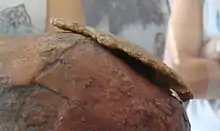 Replica of skull fragment VM-0, on an archaic human endocranial cast | |
| Catalog no. | VM-10 |
|---|---|
| Common name | Man of Orce |
| Age | Adult |
| Place discovered | Orce, |
| Date discovered | 1982 |
| Discovered by | Josep Gibert |
| This fossil dates from 1,4 Mya, from the Quaternary geological period, in the Early Pleistocene geological era, and it belongs to the first human traces in Europe | |
The Man of Orce is the name given to the fossil skull fragment noted VM-0, discovered in 1982 by Spanish paleoanthropologist Josep Gibert in the Venta Micena deposit in Orce, Spain.[1] The fragments include a piece of right parietal bone, a piece of left parietal bone, part of the sagittal suture and part of the occipital bone.
Because of its incomplete nature, this fossil was the subject of a controversy that never died down: it was suggested that it was a fragment of the skull of a young equid, not a human. The discoverer, Josep Gibert, devoted the rest of his life to disproving this theory.
History
The fossil was found in 1982 and the discovery published in 1983, but subsequent cleaning of the skull in 1984 revealed a strange little ridge at its top.
Josep Gibert was invited to France by Henry and Marie-Antoinette de Lumley, famous French paleoanthropologists, to study the skull in more detail. Marie-Antoinette de Lumley declared that it could be the skull of a young donkey, given the type of crest common to equids. The discovery group split between the two colleagues who accepted the idea,[2] and Josep Gibert who rejected it. On May 12 1984, El País published an article detailing these radically opposed interpretations.

The confusion created was immense, and over the next four days the newspaper ran eleven more articles, with interviews with scientists and obligatory caricatures. The situation gave rise to an obvious complex, between the Spanish scientists who wouldn't know a donkey from a man, and the prestigious couple of world-famous and indisputable French scientists, referred to as the "emperors" of paleoanthropology, and a little later as "scientific colonialists". In the spring of 1986, Gibert was refused an excavation permit by the autonomous region of Andalusia.
The various scientific congresses that took place in the meantime, where Gibert or Lumley mentioned the skull, did not allow for debate. Gibert went on to write a book, published in 2004, as well as 138 articles, 27 of which were published in scientific journals, to defend his point of view.[3] Gibert was gradually admitted to other sites. In 2006, the skull of a child from Roman times was discovered, with the same crest on the skull. The press finally saw this as proof that he was right. But Gibert died in October 2007, and his remains were scattered around the Venta Micena site.[4]
Since then, the Child of Orce tooth has confirmed the presence of human fossils from the same period in deposits in the Orce region.[5]
See also
References
- ↑ Gibert, Josep; Agustí, Jordi; Moyà-Solà, Salvador (1983). "Presencia de Homo sp. en el yacimiento del Pleistoceno inferior de Venta Micena (Orce, Granada)". Paleontologia i evolució (in Spanish). ISSN 0211-609X.
- ↑ Agustí, J.; Moyá-Solá, S. (1987). "Sobre la identidad del fragmento craneal atribuido a Homo sp. en Venta Micena (Orce Granada)". Estudios Geológicos (in Spanish). 43 (6). doi:10.3989/egeol.87435-6621.
- ↑ Gibert, J.; Ribot, F.; Gibert, P.; Gibert, L. (December 2006). "Obliteration study of lambdatic and obelionic region sutures in ruminant, carnivores and hominids". Estudios Geológicos. 62 (1): 123–134. doi:10.3989/egeol.0662112. hdl:2445/59736. ISSN 0367-0449.
- ↑ Carandell Baruzzi, Miquel (2013). "Homínidos, dudas y grandes titulares: La controversia del Hombre de Orce en la prensa española (1983-2007)". Dynamis (in Spanish). 33 (2): 365–387.
- ↑ Toro-Moyano, Isidro (July 2013). "The oldest human fossil in Europe dated to ca. 1.4 Ma at Orce (Spain)". Journal of Human Evolution. 65 (1): 1–9. doi:10.1016/j.jhevol.2013.01.012. hdl:10072/338463.